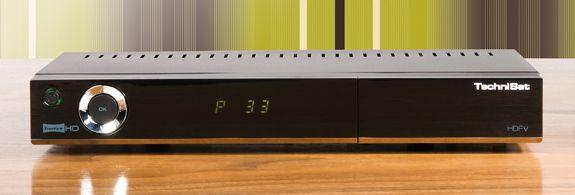Technisat HDFV review

Although Freeview HD+ PVRs are starting to appear on dealers’ shelves, some might want to dip their toe into these terrestrial high-definition waters with a basic receiver. This elegant and nicely-built HDFV is one such product. However, by plugging a USB memory stick or HDD into its USB port you can record and play back programmes – standard and high-definition alike.
The HDFV only includes one tuner so you can’t record one programme while viewing another. Unless, of course, your TV has the necessary digital tuner. Some of you may ask whether USB recordings can be transferred to a PC, perhaps for conversion into DivX HD or DVD/Blu-ray authoring, They can indeed, thanks to standard FAT32 drive-formatting, but there’s a sting in the tail. You can identify the files that take the form of transport streams from their .ts extension.
But even if you have compatible playback software such as TSplayer or VLC, you’ll have no joy here. Not even a professional transport stream analyser could make sense of these files. TechniSat told us this is because the HDFV encrypts all USB recordings – whether radio or TV – on the fly. Worse still, they can only be played on that specific unit. But you can’t blame them. While an easily accessible source of off-air HD material would, of course, be a Godsend for a pirate (or file sharer), it would, naturally, be a nightmare for the Freeview folks and broadcasters.
Thanks to an Ethernet port, you can plumb the HDFV into your home network. Although a wireless dongle presents you with a Wi-Fi alternative, this optional device connects to the receiver via USB. And as there’s only one USB port on the HDFV, you can’t record while you’re connected wirelessly. I tried a USB hub, but it was completely incompatible.
So why bother with networking? First of all, it should let you view iPlayer content. Well, theoretically at least, because you certainly can’t with the present firmware. But what you can do now is access any content that resides in your networked PC’s shared folders. uPnP servers are also visible, and this is a real AV boon, because a networked media player has effectively been thrown in for free. But there’s a caveat. Only MPEG2 files (including transport-streams recorded by other PVRs and PC tuners) are compatible. DivX and mkv/x.264 files won’t play, although JPEGs and MP3s will. These can also be fed into the HDFV via USB.
But back to the HDFV’s primary purpose. You don’t get HD+ PVR features like Series Link, but an onboard timer can be scheduled from the EPG or manually. Timeshifting to USB is another option, and the HDFV lets you save the buffer if you want to keep the programme.
Recordings can be edited, bookmarked or even archived to a networked PC (but they won’t actually play on it). Practically, the HDFV doesn’t disappoint. The text-driven user interface looks a little old-fashioned, but it’s friendly and very responsive.
I like touches such as the EPG bargraphs that indicate how long programmes have left; other Freeview staples, such as digital teletext, EPG searches/genre-listing, support for multiple soundtracks and subtitles are all present.
Installation was problem-free, too, as all initial steps are wizard-driven. Everything else, including AV/network configuration and retuning is taken care of by a sensible set of menus. It was among these that I discovered the 1080p mode of the HDFV’s HDMI port. Nothing is being broadcast in this format, but HD content is being de-interlaced here. Standard-def content, meanwhile, is de-interlaced and then upscaled.
PerformanceIn performance terms, the HDFV acquits itself rather well. For starters, it seems to be very sensitive. Despite erecting an expensive aerial a few years ago (ironically, to bring in the terrestrial HDTV test transmissions), the signal-strength of the Crystal Palace Freeview HD channels (channel 31) was very low in my South-Eastern location. (You can check specific multiplexes in the Diagnostics menu). Yet the HDFV managed to hold onto these channels with a vice-like grip.
HD channels impressed me, with lifelike colour and impeccable detailing clearly displayed on a Full HD Samsung TV. Of course, standard-definition didn’t fare as well, but it was on a par with HDMI-interfaced Freeview gear, with a surprising freedom from upscaling artifacts.
You might want to toggle between the various hi-def modes (720p and 1080i are also supported) and settle on one that best matches your display. Sound quality, through digital and analogue outputs, was fine. Overall, TechniSat’s HDFV is a decent Freeview HD receiver with some neat multimedia talents, and is easily recommended.
HCC VERDICT
Technisat HDFV
Price: £150 Approx
Highs: Performance; responsive user interface; PVR upgrade path
Lows: Recording limitations; multimedia playback natively-supports few formats; no iPlayer support yet; only one USB port Performance: 5/5
Design: 4/5
Features: 4/5
Overall: 4/5
Specifications
HDD/PVR: no/yes add your own USB memory device or HDD
Tuner: yes one DVB-T/T2
Upscaling: yes
HDMI: yes
Component: no
Digital audio: yes coaxial or via HDMI
Dimensions: 280(w) x 155(d) x 37(h)mm
Weight: 1.5kg
Also featuring: Freeview HD support; PVR and timeshift via USB; RGB Scart analogue standard-def output; 124-event timer; sleep timer; active-aerial power option; networked and USB multimedia playback; optional wi-fi adaptor; parental controls; AV sync delay adjustment; HDMI CEC; editing/bookmarking of recordings; favourite channels lists; JPEG slideshows; card reader for Pay TV upgrades (hardware present but not yet supported by firmware); three-year warranty
 |
Home Cinema Choice #351 is on sale now, featuring: Samsung S95D flagship OLED TV; Ascendo loudspeakers; Pioneer VSA-LX805 AV receiver; UST projector roundup; 2024’s summer movies; Conan 4K; and more
|







































